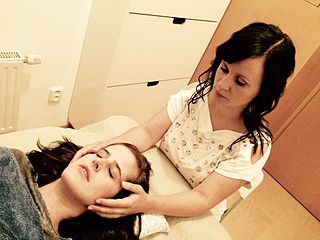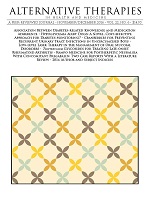Alternative medicine is any practice that aims to achieve the healing effects of medicine despite lacking biological plausibility, testability, repeatability, or evidence from clinical trials. Unlike modern medicine, which employs the scientific method to test plausible therapies by way of responsible and ethical clinical trials, producing repeatable evidence of either effect or of no effect, alternative therapies reside outside of medical science and do not originate from using the scientific method, but instead rely on testimonials, anecdotes, religion, tradition, superstition, belief in supernatural "energies", pseudoscience, errors in reasoning, propaganda, fraud, or other unscientific sources. Frequently used terms for relevant practices are New Age medicine, pseudo-medicine, holistic medicine, unorthodox medicine, fringe medicine, and unconventional medicine, with little distinction from quackery.

Chiropractic is a form of alternative medicine concerned with the diagnosis, treatment and prevention of mechanical disorders of the musculoskeletal system, especially of the spine. It has esoteric origins and is based on several pseudoscientific ideas.

Naturopathy, or naturopathic medicine, is a form of alternative medicine. A wide array of pseudoscientific practices branded as "natural", "non-invasive", or promoting "self-healing" are employed by its practitioners, who are known as naturopaths. Difficult to generalize, these treatments range from outright quackery, like homeopathy, to widely accepted practices like certain forms of psychotherapy. The ideology and methods of naturopathy are based on vitalism and folk medicine rather than evidence-based medicine, although practitioners may use techniques supported by evidence.
Magnetic therapy is a pseudoscientific alternative medicine practice involving the weak static magnetic field produced by a permanent magnet which is placed on the body. It is similar to the alternative medicine practice of electromagnetic therapy, which uses a magnetic field generated by an electrically powered device. Magnet therapy products may include wristbands, jewelry, blankets, and wraps that have magnets incorporated into them.
Reiki is a Japanese form of energy healing, a type of alternative medicine. Reiki practitioners use a technique called palm healing or hands-on healing through which a "universal energy" is said to be transferred through the palms of the practitioner to the patient in order to encourage emotional or physical healing.
The National Center for Complementary and Integrative Health (NCCIH) is a United States government agency which explores complementary and alternative medicine (CAM). It was initially created in 1991 as the Office of Alternative Medicine (OAM), and renamed the National Center for Complementary and Alternative Medicine (NCCAM) before receiving its current name in 2014. NCCIH is one of the 27 institutes and centers that make up the National Institutes of Health (NIH) within the United States Department of Health and Human Services.

Craniosacral therapy (CST) or cranial osteopathy is a form of alternative therapy that uses gentle touch to palpate the synarthrodial joints of the cranium. CST is a pseudoscience and its practice has been characterized as quackery. It is based on fundamental misconceptions about the physiology of the human skull and is promoted as a cure-all for a variety of health conditions.
Mind–body interventions (MBI) or mind-body training (MBT) are health and fitness interventions that are intended to work on a physical and mental level such as yoga, tai chi, and Pilates.
Manual therapy, or manipulative therapy, is a physical treatment primarily used by physical therapists, physiotherapists, occupational therapists to treat musculoskeletal pain and disability; it mostly includes kneading and manipulation of muscles, joint mobilization and joint manipulation. It is also used by Rolfers, massage therapists, athletic trainers, osteopaths, and physicians.

Edzard Ernst is a retired British-German academic physician and researcher specializing in the study of complementary and alternative medicine. He was Professor of Complementary Medicine at the University of Exeter, allegedly the world's first such academic position in complementary and alternative medicine.

Alternative cancer treatment describes any cancer treatment or practice that is not part of the conventional standard of cancer care. These include special diets and exercises, chemicals, herbs, devices, and manual procedures. Most alternative cancer treatments do not have high-quality evidence supporting their use and many have been described as fundamentally pseudoscientific. Concerns have been raised about the safety of some purported treatments and some have been found unsafe in clinical trials. Despite this, many untested and disproven treatments are used around the world. Promoting or marketing such treatments is illegal in most of the developed world.
Energy medicine is a branch of alternative medicine based on a pseudo-scientific belief that healers can channel "healing energy" into a patient and effect positive results. Practitioners use a number of names including various synonyms for medicine and sometimes use the word vibrational instead of or in concert with energy. In most cases there is no empirically measurable energy involved: the term refers instead to so-called subtle energy. Practitioners may classify practice as hands-on, hands-off, and distant where the patient and healer are in different locations. Many schools of energy healing exist using many names: for example, biofield energy healing, spiritual healing, contact healing, distant healing, therapeutic touch, Reiki or Qigong.

The Journal of Alternative and Complementary Medicine is a monthly peer-reviewed medical journal covering alternative medicine published by Mary Ann Liebert. It was established in 1995 and is the official journal of the Society for Acupuncture Research. The editor-in-chief is John Weeks, who succeeded the founding editor, Kim A. Jobst.
The Office of Cancer Complementary and Alternative Medicine (OCCAM) is an office of the National Cancer Institute (NCI) in the Division of Cancer Treatment and Diagnosis. OCCAM was founded in 1998 and is responsible for NCI's research agenda in pseudoscientific complementary and alternative medicine (CAM), as it relates to cancer prevention, diagnosis, treatment, and symptom management. The OCCAM differs from the National Center for Complementary and Integrative Health in that it is exclusively focused on cancer, while the NCCIH funds a much broader program of NIH research into CAM for all diseases and disorders. It last produced an annual report in 2011 and spent $105 million on CAM research in 2011.

The Friends of Science In Medicine (FSM) is an Australian association which supports evidence-based medicine and strongly opposes the promotion and practice of unsubstantiated therapies that lack a scientifically plausible rationale. They accomplish this by publicly raising their concerns either through direct correspondence or through media outlets. FSM was established in December 2011 by Loretta Marron, John Dwyer, Alastair MacLennan, Rob Morrison and Marcello Costa, a group of Australian biomedical scientists and clinical academics.

Kimball C. Atwood IV is an American medical doctor and researcher from Newton, Massachusetts. He is retired as an assistant clinical professor at Tufts University School of Medicine and anesthesiologist at Newton-Wellesley Hospital.
Complementary Therapies in Medicine is a bimonthly peer-reviewed medical journal covering complementary and alternative medicine. It was established in 1986 as Complementary Medical Research, obtaining its current name in 1993. Although it was originally published three times per year by Routledge, it is now published bimonthly by Elsevier. The editor-in-chief is Kathi Kemper. According to the Journal Citation Reports, the journal has a 2018 impact factor of 1.979.

Alternative Therapies in Health and Medicine is a bimonthly peer-reviewed medical journal covering alternative medical treatments. It publishes case reports, original research papers, and systematic reviews. It was established in 1995 by founding editor Larry Dossey and is published bimonthly by InnoVision Health Media. The current editor-in-chief is Andrew W. Campbell.
Alternative medicine describes any practice which aims to achieve the healing effects of medicine, but which lacks biological plausibility and is untested or untestable. Complementary medicine (CM), complementary and alternative medicine (CAM), integrated medicine or integrative medicine (IM), and holistic medicine are among many rebrandings of the same phenomenon.








